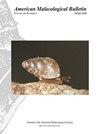Caecidae (Gastropoda: Truncatelloidea) Associated with Unconsolidated Carbonate Substrates of the Abrolhos Coral Bank (Bahia State, Brazil)
IF 0.4
4区 生物学
Q4 MARINE & FRESHWATER BIOLOGY
引用次数: 1
Abstract
In this study, we present mollusks of the family Caecidae Gray, 1850 collected between 2007 and 2008 from unconsolidated carbonate substrates of the Abrolhos coral bank during the PROABROLHOS Project (Productivity, Sustainability and Use of the Abrolhos Bank Ecosystem). A total of 649 individuals belonging to two genera and six species were collected from nine stations at depths of 15.6 to 22 m in the dry and rainy seasons. The most abundant species were Caecum brasilicum de Folin, 1874 and Caecum floridanum Stimpson, 1851. Caecum circumvolutum de Folin, 1867, Caecum metamorphosicum Lima, Santos & Absalao, 2013, Meioceras cubitatum de Folin, 1868 and Meioceras nitidum (Stimpson 1851) altogether comprised approximately 6.5% of the total number of individuals collected. Among the 14 species previously recorded for the Abrolhos coral reef area, Caecum metamorphosicum is for the first time registered in the area in this study. This calls attention that, overall, there is a need for more researches focused on the carbonate substrate in coral areas, especially on micro specimens.与Abrolhos珊瑚岸(巴西巴伊亚州)松散碳酸盐基质有关的Caecidae(腹足目:Truncatelloide)
在这项研究中,我们介绍了在PROABROLHOS项目(阿布罗霍斯珊瑚岸生态系统的生产力、可持续性和使用)期间,从阿布罗霍斯斯珊瑚岸的松散碳酸盐基质中收集的灰蝶科软体动物,1850只。在旱季和雨季,从15.6至22m深度的9个站点共采集了649个个体,隶属于2属6种。最丰富的物种是brasilicum de Folin,1874年和floridanum Stimpson,1851年。Caecum circuvolutum de Folin,1867,Caecum morphoosicum Lima,Santos&Absalao,2013,Meioceras cubitatum de Folin1868和Meiocers nitidum(Stimpson 1851)总共约占收集到的个体总数的6.5%。在Abrolhos珊瑚礁区先前记录的14个物种中,Caecum morphosicum是本研究首次在该地区登记。这引起了人们的注意,总的来说,有必要对珊瑚区的碳酸盐基质进行更多的研究,特别是对微观标本的研究。
本文章由计算机程序翻译,如有差异,请以英文原文为准。
求助全文
约1分钟内获得全文
求助全文
来源期刊
CiteScore
1.00
自引率
40.00%
发文量
1
审稿时长
>12 weeks
期刊介绍:
The American Malacological Bulletin serves as an outlet for reporting notable contributions in malacological research. Manuscripts concerning any aspect of original, unpublished research,important short reports, and detailed reviews dealing with molluscs will be considered for publication. Recent issues have included AMS symposia, independent papers, research notes,and book reviews. All published research articles in this journal have undergone rigorous peer review, based on initial editor screening and anonymous reviewing by independent expertreferees. AMS symposium papers have undergone peer review by symposium organizer, symposium participants, and independent referees.

 求助内容:
求助内容: 应助结果提醒方式:
应助结果提醒方式:


